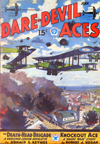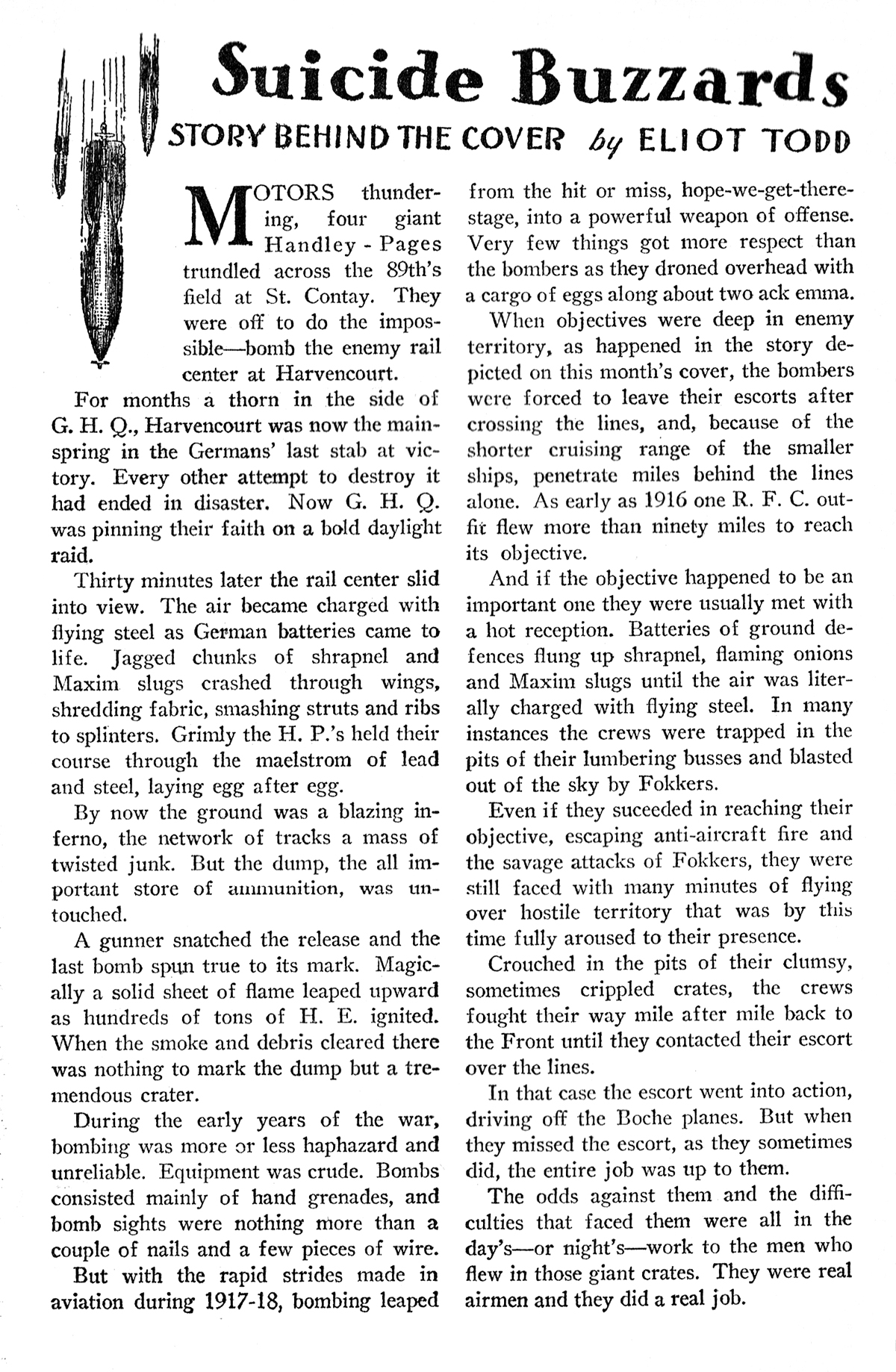“Suicide Buzzards” by Eliot Todd
Frederick Blakeslee painted all the covers for the entire run of Dare-Devil Aces. And each of those covers had a story behind it. This time, Eliot Todd recounts the story behind Blakeslee’s July 1934 cover for Dare-Devil Aces. . . .
 MOTORS thundering, four giant Handley-Pages trundled across the 89th’s field at St. Contay. They were off to do the impossible—bomb the enemy rail center at Harvencourt.
MOTORS thundering, four giant Handley-Pages trundled across the 89th’s field at St. Contay. They were off to do the impossible—bomb the enemy rail center at Harvencourt.
For months a thorn in the side of G.H.Q., Harvencourt was now the mainspring in the Germans’ last stab at victory. Every other attempt to destroy it had ended in disaster. Now G.H.Q. was pinning their faith on a bold daylight raid.
Thirty minutes later the rail center slid into view. The air became charged with flying steel as German batteries came to life. Jagged chunks of shrapnel and Maxim slugs crashed through wings, shredding fabric, smashing struts and ribs to splinters. Grimly the H.P.’s held their course through the maelstrom of lead and steel, laying egg after egg.
By now the ground was a blazing inferno, the network of tracks a mass of twisted junk. But the dump, the all important store of ammunition, was untouched.
A gunner snatched the release and the last bomb spun true to its mark. Magically a solid sheet of flame leaped upward as hundreds of tons of H.E. ignited. When the smoke and debris cleared there was nothing to mark the dump but a tremendous crater.
During the early years of the war, bombing was more or less haphazard and unreliable. Equipment was crude. Bombs consisted mainly of hand grenades, and bomb sights were nothing more than a couple of nails and a few pieces of wire.
But with the rapid strides made in aviation during 1917-18, bombing leaped from the hit or miss, hope-we-get-there-stage, into a powerful weapon of offense. Very few things got more respect than the bombers as they droned overhead with a cargo of eggs along about two ack emma.
When objectives were deep in enemy territory, as happened in the story depicted on this month’s cover, the bombers were forced to leave their escorts after crossing the lines, and, because of the shorter cruising range of the smaller ships, penetrate miles behind the lines alone. As early as 1916 one R.F.C. outfit flew more than ninety miles to reach its objective.
And if the objective happened to be an important one they were usually met with a hot reception. Batteries of ground defences flung up shrapnel, flaming onions and Maxim slugs until the air was literally charged with flying steel. In many instances the crews were trapped in the pits of their lumbering busses and blasted out of the sky by Fokkers.
Even if they sucecded in reaching their objective, escaping anti-aircraft fire and the savage attacks of Fokkers, they were still faced with many minutes of flying over hostile territory that was by tins time fully aroused to their presence.
Crouched in the pits of their clumsy, sometimes crippled crates, the crews fought their way mile after mile back to the Front until they contacted their escort over the lines.
In that case the escort went into action, driving off the Boche planes. But when they missed the escort, as they sometimes did, the entire job was up to them.
The odds against them and the difficulties that faced them were all in the day’s—or night’s—work to the men who flew in those giant crates. They were real airmen and they did a real job.

“Suicide Buzzards: The Story Behind The Cover” by Eliot Todd (July 1934)
Check back again. We will be presenting more Stories behind the Covers.




